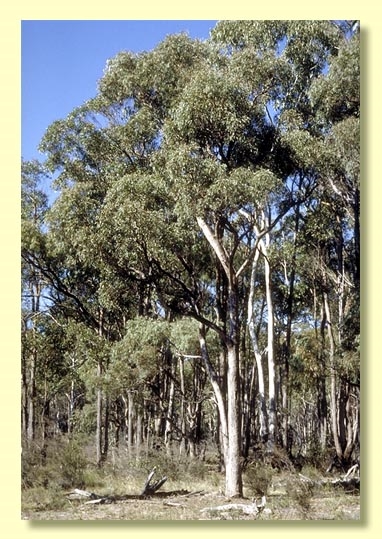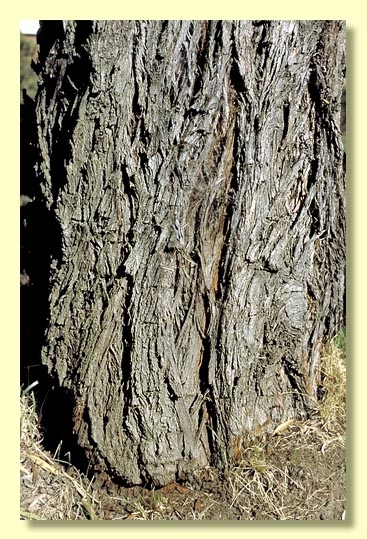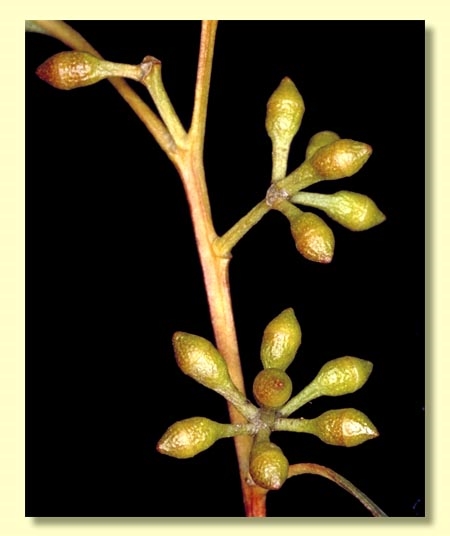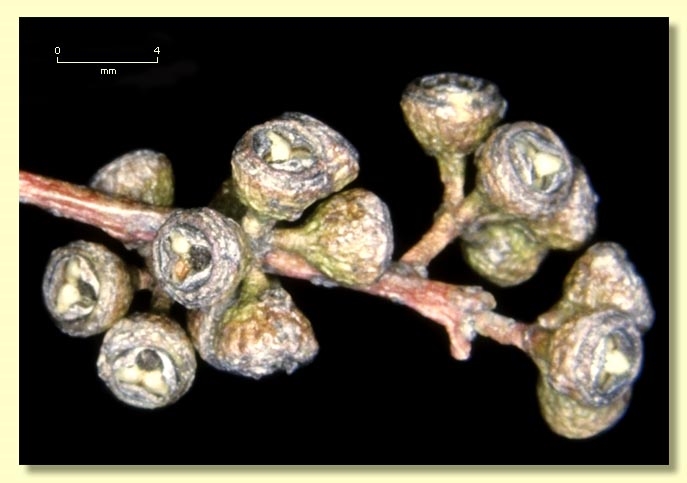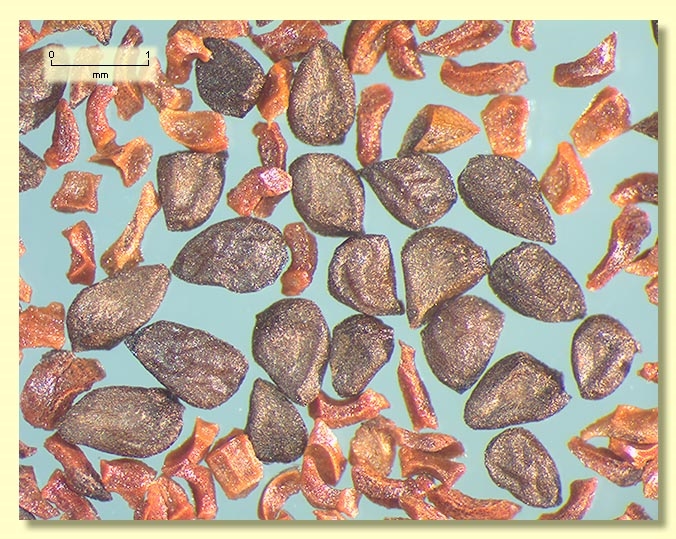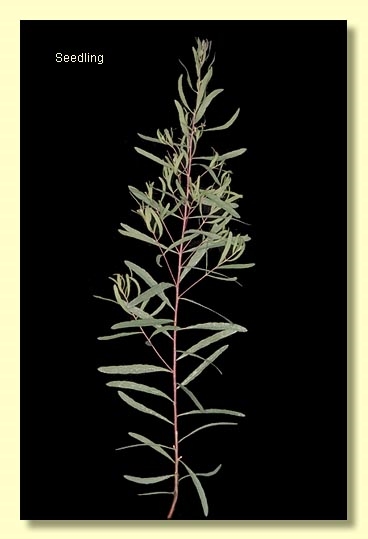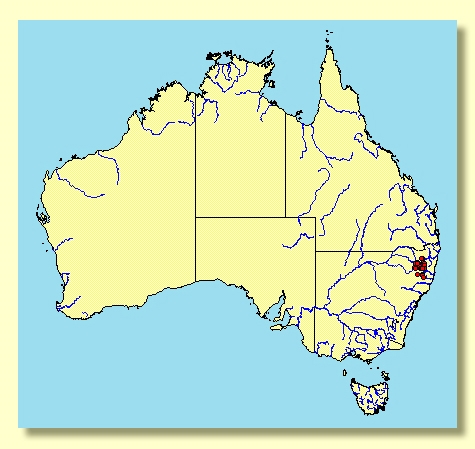Euclid - Online edition
Eucalyptus nicholii
Eucalyptus | Symphyomyrtus | Maidenaria | Triangulares | Acaciiformes
E. acaciiformis var. linearis H.Deane & Maiden, Proc. Linn. Soc. New South Wales 24: 455 (1899). T: 16–17 miles [c. 28 km] E of Walcha, NSW, Nov. 1897, J.H.Maiden; lecto: NSW fide J.H.Maiden, Crit. Revis. Eucalyptus 3: 43 (1914); .isolecto: BM, K, MEL.
Bark rough to small branches, thick, fibrous, grey or grey-brown, longitudinally furrowed.
Juvenile growth (coppice or field seedlings to 50 cm): stem rounded in cross-section; juvenile leaves sessile to shortly petiolate, opposite for 5 or 6 pairs then sub-opposite to alternate, linear to narrowly lanceolate, 2–6.5 cm long, 0.2–1 cm wide, dull, grey-green.
Adult leaves alternate, petiole 0.5–1.5 cm long; blade narrowly lanceolate, 6–14 cm long, 0.5–1.2 cm wide, base tapering to petiole, concolorous, usually dull, greenish grey, side-veins acute, moderately to densely reticulate, intramarginal vein parallel to and just within margin or remote from it, oil glands mostly island.
Inflorescence axillary unbranched, peduncles 0.3–0.8 cm long, buds 7 per umbel, pedicels 0.2–0.4 cm long. Mature buds ovoid, 0.3–0.5 cm long, 0.2–0.3 cm wide, smooth, scar present, operculum conical, stamens irregularly flexed, anthers cuboid to oblong, versatile, dorsifixed, dehiscing by longitudinal slits (non-confluent), style long, stigma pin-head shaped or blunt, locules 3 or 4, the placentae each with 4 vertical ovule rows. Flowers white.
Fruit on pedicels 0.1–0.3 cm long, hemispherical to campanulate or obconical, 0.3–0.4 cm long, 0.3–0.5 cm wide, disc level or disc raised-convex to annular, valves 3 or 4, slightly exserted.
Seeds brown, 1–1.5 mm long, ovoid or flattened-ovoid, often pointed at one end, not lacunose or furrowed, dorsal surface smooth, hilum ventral.
Cultivated seedlings (measured at ca node 10): cotyledons oblong; stems rounded in cross-section; leaves subsessile, opposite for 5 or 6 nodes then subopposite to alternate, linear to lanceolate, 3.5–6.5 cm long, 0.2–1.2 cm wide, base tapering, margin entire, green to grey-green.
Flowering has been recorded in March.
Eucalyptus nicholii is widely planted as a municipal and domestic ornamental tree in south-eastern Australia.
A small to medium-sized tree of the Northern Tablelands of New South Wales from south of Armidale north to Glen Innes, usually confined to the granite and porphryry soils. E. nicholii belongs to the large group of rough-barked, small-fruited species. It is notable for the rough bark to the branchlets, small, narrow, dull, grey leaves (light green when immature) and distinctly pedicellate, delicate buds and fruit. The rough bark allies it to E. acaciiformis, which differs in the broader adult leaves, the narrowly elliptical juvenile leaves and the fruit with slightly exserted valves while in E. nicholii the juvenile leaves are linear and crowded.
Eucalyptus nicholii belongs in Eucalyptus subgenus Symphyomyrtus section Maidenaria, a large group of species more or less restricted to south-eastern Australia, characterised by bilobed cotyledons, simple axillary inflorescences, buds with two opercula, stamens with versatile anthers and flattened seeds with a ventral hilum. Within this section E. nicholii and five other species form series Acaciiformes diagnosed by the rough bark, juvenile leaves that are soon alternate, glandular adult leaves, non-swampy habitat, and small, rather flat-topped fruit. Three of these species—E. ignorabilis, E. fulgens and E. aromaphloia—are restricted to southern Victoria and far south-eastern New South Wales, whilst E. corticosa is a rare species from east of Rylstone in central New South Wales. The remaining two species, E. acaciiformis and E. nicholii, differ as discussed above.
Eucalyptus nicholii is listed as "Vulnerable" under the Australian Government Environment Protection and Biodiversity Conservation Act 1999 (EPBC Act). Further information may be found at this web address:
http://www.environment.gov.au/cgi-bin/sprat/public/sprat.pl

